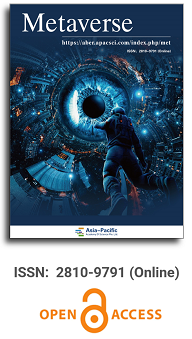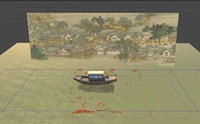
Asia Pacific Academy of Science Pte. Ltd. (APACSCI) specializes in international journal publishing. APACSCI adopts the open access publishing model and provides an important communication bridge for academic groups whose interest fields include engineering, technology, medicine, computer, mathematics, agriculture and forestry, and environment.


Full Issue
| View or download the full issue |
Issue release: 30 June, 2024
Welcome to the latest issue of Metaverse, where we explore the intersection of technology, art, and society in this rapidly evolving digital landscape. This issue delves into diverse aspects of the metaverse, from the integration of AI in creative processes to advancements in autonomous vehicle localization, and blockchain-based cybersecurity in mobile commerce.
Issue release: 30 June, 2024
Purpose: Parametric design has become one of the most important means of sedan design. The purpose of this paper is to construct a linear regression model to explore the matching relationship between Kansei words and the morphological elements of sedan wheels and to incorporate perceptual factors into the rational thinking of parametric wheel hub design. Design/methodology/approach: To forecast the matching relationship between wheel shape design features and semantics, this research offers a multiple linear regression model. First, using sample similarity matrix data analysis and offline research, 20 typical samples of car wheels were collected. Third, the wheel shape design elements are obtained by applying the semantic difference (SD) method to four groups of users’ evaluation data on the perceived words of the car wheels. Firstly, the wheel shape is divided into six basic features and seventeen subdivided features using morphological analysis. The collected car wheel samples are then researched and coded. Ultimately, a multiple linear regression model is built utilizing shape coding matching to the styles to direct the wheel parametric design process, yielding sedan wheel design schemes with various semantics of style. Findings: The results show that the regression models can provide good prediction performance (R2 values are greater than 0.7). This study shows that the use of multiple regression models can accurately and cost-effectively predict the wheel hub morphological elements that meet the user’s perceptual needs through morphological elements and Kansei words. Originality/value: This paper is the first to use a multiple regression model to predict a parametric wheel shape that fits the user’s sensibility, which helps the user to present and feel the design scheme in a digital environment. The different wheel hub schemes generated by parametric design can be virtually displayed in the metaverse, helping users and designers to carry out more convenient scheme selections.
Issue release: 30 June, 2024
This article examines the complex dynamics between avatars and in-game advertising, probing how virtual representations influence consumer behavior within digital environments. It delves into the psychological interplay between self-perception and avatar embodiment, suggesting that while younger users may treat avatars as accessories showcasing personal interests, adults tend to opt for idealized selves, affecting their interaction with and responsiveness to virtual marketing. The study contemplates the avatar’s function as both a consumer and influencer in the expanding metaverse, considering the escalating integration of branded items in games. It also highlights potential shifts in consumption patterns as digital and physical realities converge. The article advocates for future research to explore the multifaceted impacts of avatars, such as age-related differences, the role of artificial intelligence in self-representation, and cross-platform avatar utilization, utilizing longitudinal data from sources like Second Life and social media profiling. In synthesizing these perspectives, the article underscores the necessity to further understand how avatars contribute to shaping digital consumerism, paving the way for a new domain in consumer psychology that navigates the evolving interface of the metaverse. The findings suggest that the nuances of digital identity formation are significant factors in the effectiveness of in-game advertising and indicate a transformative phase in marketing strategies tailored for virtual worlds.
Issue release: 30 June, 2024
This study aims to propose the integration of cyber security measures with sustainable mobile commerce platforms and evaluate their efficacy in promoting social entrepreneurship and sustainability in the field of mobile commerce. A platform was developed for Android and iOS platforms using the Flutter Framework and Dart Programming Language, and it included features designed to help social entrepreneurs and non-profit organizations connect with potential donors, volunteers, and partners. The study includes participants from social entrepreneurs, non-profit organizations, and potential donors who are recruited to use the platform to create and promote their social business projects and to provide feedback on their experience using the platform. The results of the integration are expected to show that the mobile platform for social business is effective in promoting social entrepreneurship and sustainable development and in connecting social entrepreneurs and non-profit organizations with potential donors and partners due to the security measures that have been taken in the application and data protection, ensuring privacy with a comparatively lower risk than other platforms. In conclusion, this paper presents a blockchain-based secure mechanism for mobile platforms for m-commerce and social business, which is a valuable tool for promoting social entrepreneurship and sustainable development. It can be used to create a positive social impact in local and, conceivably, international communities. The proposal explicitly explains the methodology and implementation of the platform and highlights the significance and impact of this research in advancing the fields of mobile commerce, social entrepreneurship, and sustainability.
Issue release: 30 June, 2024
Text-to-video generation (T2V) has recently attracted more attention due to the wide application scenarios of video media. However, compared with the substantial advances in text-to-image generation (T2I), the research on T2V remains in its early stage. The difficulty mainly lies in maintaining the text-visual semantic consistency and the video temporal coherence. In this paper, we propose a novel distillation and translation GAN (DTGAN) to address these problems. First, we leverage knowledge distillation to guarantee semantic consistency. We distill text-visual mappings from a well-performing T2I teacher model and transfer it to our DTGAN. This knowledge serves as shared abstract features and high-level constraints for each frame in the generated videos. Second, we propose a novel visual recurrent unit (VRU) to achieve video temporal coherence. The VRU can generate frame sequences as well as process the temporal information across frames. It enables our generator to act as a multi-modal variant of the language model in neural machine translation task, which iteratively predicts the next frame based on the input text and the previously generated frames. We conduct experiments on two synthetic datasets (SBMG and TBMG) and one real-world dataset (MSVD). Qualitative and quantitative comparisons with state-of-the-art methods demonstrate that our DTGAN can generate results with better text-visual semantic consistency and temporal coherence.
Issue release: 30 June, 2024
As special marks on a human face, facial landmarks reflect the facial features of various parts of the face, which is crucial in biomedicine and medical imaging. In addition, facial landmarks are also important features in computer vision such as face detection, face recognition, facial pose estimation, and facial animation. In this paper, we construct a 3D facial acupoint annotated dataset by labeling 37 facial acupoints on 846 neutral face triangle mesh on the FaceScape dataset. Based on these annotated data, we use a feature template matching method to realize the automatic annotation of 37 acupoints on triangle meshes. We used 40 meshes as the training set to extract the geometric patterns of 3D acupoints and then measured the performance of the automatic labeling algorithm on 20 meshes and 806 meshes as the test sets. In the training process, we extract the tangent plane for each landmark, project the neighbor vertices of the landmark to the tangent plane, and construct the feature image with R × R resolution through the bounding box of the projected points. In the testing process, we use the pattern images extracted during training to find the average features and use them as a guide to optimize the predicted landmarks. The experimental results show that our automatic acupoint labeling method has achieved good results.
Issue release: 30 June, 2024
This comprehensive analysis delves into the historical progression and important technological and contemporary advancements of computer vision inside the metaverse. The metaverse, which can be characterized as an interactive virtual reality environment that mirrors the physical world, signifies a novel domain for the utilization of computer vision in various applications. These applications span from object identification and tracking to gesture recognition and augmented reality. Additionally, a thorough evaluation of specific case studies occurs to provide a deeper understanding of the subject. Despite notable progress, the incorporation and utilization of computer vision inside the metaverse present numerous obstacles, including computational expenses, apprehensions regarding data privacy, and the faithful replication of physical aspects of reality. Potential solutions are examined, including deep learning approaches, optimization strategies, and the formation of ethical guidelines. A comprehensive analysis of anticipated patterns within the industry is also included, with emphasis on the confluence of artificial intelligence, the Internet of Things, and blockchain technologies. These convergences are predicted to create substantial prospects for the advancement of the metaverse. This review culminates by offering a contemplation on the ethical considerations and duties that arise from the utilization of computer vision in the realm beyond mortal existence. Research findings demonstrate that these technologies have greatly augmented user engagement and immersion within the digital domain. Readers can enhance their understanding of the interdependent connection between computer vision and the metaverse through the present analysis of existing scholarly works. Thus, this study aspires to make a valuable contribution to the advancement of research in this new domain.
Issue release: 30 June, 2024
This paper explores the multifaceted landscape of Non-Fungible Tokens beyond their role in digitizing artworks. It delves into the intersection of art, utility, and cultural preservation within the NFT realm. The discussion revolves around the duality of “art for art’s sake” and functional utility, sparking ongoing debates about the essence of art in both the analog and digital realms. The convergence of contemporary aesthetics with practical token utility challenges conventional definitions, offering an alternative to narrative retrieval and contributing to cultural preservation in the virtual sphere. As one enters the NFT ecosystem, a utopian quest for autonomy in healthy production becomes evident, albeit not without formidable obstacles. The paper examines the promise of NFTs to liberate creators from intermediary control and the entwined complexities accompanying their evolution. It sheds light on the cautious and ethical approach required for the mass adoption of these technologies, contrasting this with the current global context characterized by rampant consumerism, individualism, and the relentless pursuit of easy financial gains.
Issue release: 30 June, 2024
This survey paper provides an in-depth analysis of localization systems for autonomous vehicles (AVs), a cornerstone technology crucial for the safe and efficient operation of AVs. The paper encompasses a comprehensive examination of various localization technologies, their comparative analysis, the challenges they face, and the emerging trends shaping their future. We begin by exploring the principal technologies employed in AV localization: GPS, LiDAR, radar, cameras, and ultrasonic sensors. Each technology is scrutinized to understand its strengths, weaknesses, and applicability in different environmental contexts. GPS offers broad geographical positioning but struggles with precision in dense urban areas. LiDAR provides high-resolution mapping but is hindered by adverse weather conditions. Radar ensures reliability in poor visibility but lacks the finer details provided by optical systems. Cameras offer rich visual data but are dependent on lighting conditions, and ultrasonic sensors, while effective for close-range detection, are limited to low-speed applications. The paper then presents a comparative analysis of these technologies against key performance metrics such as accuracy, reliability, latency, scalability, and cost-effectiveness. This analysis is critical in understanding the suitability of each technology for various driving scenarios, from congested urban streets to open highways and in diverse weather conditions. Challenges in AV localization are multifaceted, encompassing technological, environmental, and system integration issues. Technological challenges include sensor limitations and computational constraints, while environmental factors like weather and urban infrastructure significantly impact localization accuracy. System integration poses another significant challenge, necessitating seamless interaction between localization systems and other vehicle control systems for real-time decision-making. Emerging trends and potential solutions to these challenges are discussed, highlighting advancements in sensor technology, AI, machine learning, and 5G communications. These developments promise to overcome existing limitations and enhance the accuracy and reliability of AV localization. The integration of localization systems with smart city infrastructures and the implementation of collaborative technologies like V2X communication are speculated to further augment AV capabilities. In conclusion, the paper emphasizes that the future of AV localization is intrinsically linked to the continuous evolution of technologies and their integration. Addressing current challenges and harnessing emerging trends are pivotal for the advancement of AVs, steering us toward a future of autonomous transportation characterized by increased safety, efficiency, and reliability.
Issue release: 30 June, 2024
Various studies have widely utilized virtual reality (VR) in painting creation. However, there has been few conclusive studies on VR painting. The present systematic literature review describes the current state of knowledge and practices using VR in painting and provides guidance for painters and scholars focusing on human computer interaction design by critically appraising and summarizing the existing research. It also outlines a wide range of results yielded by quantitative, qualitative and mixed-method studies to investigate potential benefits, difficulties, and effectiveness of VR painting. Overall, 44 studies published from 2013 until 2023 were analysed, with 16 articles introduced the hardware technology and interaction mode of VR painting, 17 articles introduced the beautification method of VR painting, and 11 articles focused on the application of VR painting in different fields. Implications for practice and research are discussed in detail, as the hardware selection, interaction, and physical simulation in VR painting scenes.
Issue release: 30 June, 2024
This article presents a comprehensive review of recent advancements in computer network technologies, emphasizing their impact on various sectors. The rapid evolution of computer networks has transformed communication, work, and business. From 5G networks and the Internet of Things (IoT) to network security and quantum networking, this review explores the current state of computer networks and their prospects.
Issue release: 30 June, 2024
This study explores the integration and challenges of metaverse technology in tourism, analyzing perspectives from the industry, travelers, and management. It underscores the digital transformation accelerated by the COVID-19 pandemic, technological advances, and Generation Z influences. The research identifies key applications of metaverse technology, such as digital eco-tours, museums, cultural performances, and souvenirs, which redefine the traditional tourism model. It also examines the unique experiences provided to tourists by the metaverse at various stages of travel—before, during, and after trips—and evaluates the implications for customer perception and behavior. From a management viewpoint, the study highlights the necessity for thorough assessments of metaverse implementations in customer relations, marketing, and organizational strategies to fully gauge its impact. The discussion section addresses the long-term effects on traditional tourism practices and destinations and articulates how these technologies transform customer engagement and operational paradigms. This research provides a comprehensive overview of how metaverse technology reshapes the tourism landscape, offering insights for future technological integration and strategic development.
Issue release: 30 June, 2024
Industrial Revolution 4.0 transforms healthcare systems. The first three technological revolutions changed the relationship between human and machine interaction due to the exponential growth of the number of machines. The fourth revolution has placed humans in a scenario where heterogeneous data is generated in unprecedented quantity and quality, not only through traditional methods enhanced by digitization, but also through ubiquitous computing, machine-to-machine interactions, and smart environment. The modern cyber-physical space underlines the role of humans in the expanding context of computerization and big data processing. In healthcare, where data collection and analysis particularly depend on human efforts, the disruptive nature of these developments is evident. Adaptation to this process requires deep scrutiny of the trends and recognition of future medical data technologies` evolution. Significant difficulties arise from discrepancies in requirements by healthcare, administrative and technology stakeholders. Black box and grey box decisions made in medical imaging and diagnostic Decision Support Software are often not transparent enough for the professional, social and medico-legal requirements. While Explainable AI proposes a partial solution for AI applications in medicine, the approach has to be wider and multiplex. LLM potential and limitations are also discussed. This paper lists the most significant issues in these topics and describes possible solutions.
Issue release: 30 June, 2024
The paper briefly describes the incorporation of several complementary subjects of art, technology, digital, and media to support the implementation of educational accessibility. The general goal is to promote the accessible metaverse for special schools related to the participation of students with different types of disability, assuming the motivation of digital/media arts activities in various interactive tools. This methodology was carried out in a documentary review to investigate the different elements of the virtual world through a metaverse analysis and new interactive tools such as school gamification. The key steps include investigating accessibility needs, creating interactive media, providing training, implementing virtual reality, and promoting social interaction; however, there are ten pillars to highlight the potential of metaverse engineering for inclusive learning in special schools, fostering creativity and collaboration while ensuring accessibility. In conclusion, metaverse educational accessibility in special schools for digital/media arts enables progress and learning through interactive tools, promoting social interaction and inclusion.

Prof. Zhigeng Pan
Director, Institute for Metaverse, Nanjing University of Information Science & Technology, China

Prof. Jianrong Tan
Academician, Chinese Academy of Engineering, China
Platform: VooV Meeting Meeting ID: 688-583-586...


 Open Access
Open Access



.jpg)
.jpg)

